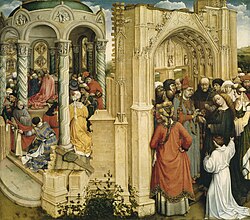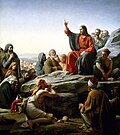
Back Separació del cristianisme primitiu del judaisme Catalan Hebreoj kaj Kristanoj de la unuaj kvin jarcentoj Esperanto Separación del cristianismo primitivo y el judaísmo rabínico Spanish Racines juives du christianisme French הפילוג היהודי-נוצרי HE A korai kereszténység és a judaizmus szétválása Hungarian Perpecahan Gereja Perdana dan Yudaisme ID Rano hrišćanstvo i judaizam Serbo-Croatian

| Part of a series on |
| Jewish Christianity |
|---|
 |
Christianity began as a movement within Second Temple Judaism, but the two religions gradually diverged over the first few centuries of the Christian Era, and the Christian movement perceived itself as distinct from the Jews by the fourth century.[2] Historians continue to debate the dating of Christianity's emergence as a discrete religion apart from Judaism.[3] Philip S. Alexander characterizes the question of when Christianity and Judaism parted company and went their separate ways (often termed the parting of the ways) as "one of those deceptively simple questions which should be approached with great care".[4] According to historian Shaye J. D. Cohen, "the separation of Christianity from Judaism was a process, not an event", in which the church became "more and more gentile, and less and less Jewish".[5] Conversely, various historical events have been proposed as definitive points of separation, including the Council of Jerusalem and the First Council of Nicaea.
Historiography of the split is complicated by a number of factors, including a diverse and syncretic range of religious thought and practice within Early Christianity and early Rabbinic Judaism (both of which were far less orthodox and theologically homogeneous in the first centuries of the Christian Era than they are today) and the coexistence of and interaction between Judaism, Jewish Christianity, and Gentile Christianity over a period of centuries at the beginning of Early Christianity.[6] Some scholars have found evidence of continuous interactions between Jewish-Christian and Rabbinic movements from the mid-to late second century CE to the fourth century CE.[7][8] The first centuries of belief in Jesus have been described by historians as characterized by religious creativity and "chaos".[9][10]
The two religions eventually established and distinguished their respective norms and doctrines, notably by increasingly diverging on key issues such as the status of "purity laws" and the validity of Judeo-Christian messianic beliefs.[citation needed]
- ^ "Parsing "The Parting" Painting: The Marriage of the Virgin". The BAS Library. Archived from the original on 2024-02-12. Retrieved 2024-02-12.
- ^ Reinhartz, Adele (2020-12-31), Greenspahn, Frederick E.; Greenspahn, Frederick E. (eds.), "5. How Christianity Parted from Judaism", Early Judaism, New York University Press, pp. 97–120, doi:10.18574/nyu/9781479896950.003.0006, ISBN 978-1-4798-2570-7, S2CID 171634920, retrieved 2024-02-12
- ^ Wylen, Stephen M. (1996). The Jews in the Time of Jesus: An Introduction. Paulist Press. ISBN 978-0-8091-3610-0.
- ^ Alexander, Philip S. "'The Parting of the Ways' from the Perspective of Rabbinic Judaism". James D. G. Dunn, ed. Jews and Christians: The Parting of the Ways, Durham-Tübingen Research Symposium on Earliest Christianity and Judaism 1992 (2nd: 1999: Wm. B. Eerdmans). p1 in the 1992 edition.
- ^ Cohen 1987, p. 228"The separation of Christianity from Judaism was a process, not an event. The essential part of this process was that the church was becoming more and more gentile, and less and less Jewish, but the separation manifested itself in different ways in each local community where Jews and Christians dwelt together. In some places, the Jews expelled the Christians; in other, the Christians left of their own accord."
- ^ Philippe Bobichon,"L'enseignement juif, païen, hérétique et chrétien dans l'œuvre de Justin Martyr", Revue des Études Augustiniennes 45/2 (1999), pp. 233-259 online Archived 2021-04-26 at the Wayback Machine
- ^ See for instance: Lily C. Vuong, Gender and Purity in the Protevangelium of James, WissenschaftlicheUntersuchungen zum Neuen Testament 2.358 (Tübingen: Mohr Siebeck,2013), 210–213; Jonathan Bourgel, "The Holders of the 'Word of Truth': The Pharisees in Pseudo-Clementine Recognitions 1.27–71", Journal of Early Christian Studies 25.2 (2017) 171–200.
- ^ Bobichon, Philippe (2002). "Autorités religieuses juives et « sectes » juives dans l'oeuvre de Justin Martyr". Revue d'Études Augustiniennes et Patristiques. 48 (1): 3–22. doi:10.1484/J.REA.5.104844. ISSN 1768-9260.
- ^ Brown, Raymond E (1983). "Not Jewish Christianity and Gentile Christianity but Types of Jewish/Gentile Christianity". Catholic Biblical Quarterly (45): 74–79.
- ^ Bibliowicz, Abel M. (2019). Jewish-Christian Relations - The First Centuries (Mascarat, 2019). WA: Mascarat. p. ????. ISBN 978-1513616483. Archived from the original on 2021-11-16. Retrieved 2020-06-19.
© MMXXIII Rich X Search. We shall prevail. All rights reserved. Rich X Search